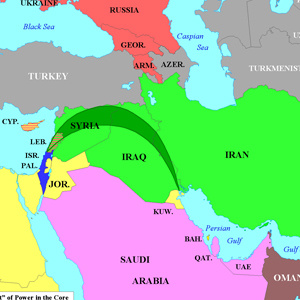The Myth of the Shia Crescent

The geopolitical state of Shias is an incontrovertible fact, but can it in anyway undermine the geopolitical position of the Sunnis? No reasonable political mind can argue that a 10% percent minority can extend its hegemony over a powerful majority. Always a minority throughout the history of Islam, Shias have also always preferred interaction and unity to hegemony as the only way to survive. As much as the concept of a ‘Shia Crescent’ should not foster a sense of false pride for ordinary Shias, it must not also cause concern for unsophisticated Sunnis. Those who exaggerate the power of a so-called Shia Crescent are actually trying to bring to the fore religious contrasts and challenges, materialize them in the socio-political arena, and ultimately bring them into the field of diplomacy. Diversity –particularly in faith- has never been absent in any community. Civil societies should regard such differences not as a threat, but as an opportunity to cross-fertilize theories and philosophies.
Hot debates over the increasing power of a ‘Shia Crescent’ aim to fuel tensions between the Shias and the Sunnis. Ironically, those Western countries that support the idea have witnessed –and engaged in- the most atrocious battles over religion before beginning to seek unity. On the other hand, at no point in its 1400-year history has the Muslim World engaged in sectarian battles and conflict comparable to the ones Catholics and Protestants have suffered for centuries.
Incidents such as the September 11 terrorist attacks and a U.S. attitude shift –from interaction to confrontation with Salafism - and a tilt in the balance of power in favor of the Shias of Iraq after the fall of Saddam, impelled King Abdullah of Jordan to coin the misleading term ‘the Shia Crescent’. And the West is dishonestly taking advantage of this newly formed concept to foment the rift between Muslims.
Iran -dubbed as the mastermind of this imaginary crescent- has time and again proven that it regards the unity of the Muslim World far more crucial than supporting the Shia population around the globe. Two examples are Iran’s proclamation designating the last Friday of Ramadan as Quds Day, and the price it had to pay when it backed both the Shia Hezbollah of Lebanon and the Sunni Hamas of Palestine. But for developers of such theories these are facts that should be ignored.
Overall, one-dimensional geopolitics neither exists nor is useful for any state. It is clear that Iraq prioritizes Arab identity over its Shia-identity majority. Policies followed by the Iraqi government towards the correct usage of the term ‘Persian Gulf’ and its approach regarding the three Iranian islands of the Persian Gulf claimed by the United Arab Emirates, are clear evidence of that. Simply limiting Iran to Shia geopolitics deprives it from access to a potential sphere of influence where the majority of dwellers are Sunnis.
It seems that behind the concept of the Shia Crescent, more than religious concerns, lies a fear of democracy in Iraq and its institutionalization—a potential threat to the authoritarian regimes in the Middle East.
Islam is intertwined with the identity of the Middle East. Serious promotion of democracy in the Middle East -while safeguarding the right of religious and ethnic minorities- could liberate Sunnis from the tyranny of their rulers. With the emergence of democratic governments in the Middle East, the Shia and Sunni will find more room for interaction. And as such, the concept of ‘The Shia Crescent’ is just a myth.

